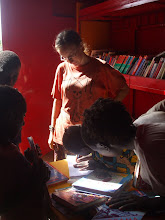It's been a pretty dry week, though people are still seeding and working the ground. Now the crops must push up their tender sprouts through a crust of cracked, dry mud. About half of the farmers I'm working with have seeded their Peace Corps improved seed; one corn field is shooting up nicely, and the beans of course look great. They're easy to please. However right now it's mostly men and work animals in the fields. Only a few are big enough for the women and girls to go in with their hand tools to weed. So I mostly wander around, poke about in the dirt if there's something I can help with, and stare indulgently at the baby crops. I'm waiting for one more good rain to settle the soil, so I can seed my own little backyard garden and demonstration plot of zai holes, out behind my hut. But, there are things to do. Yesterday I accompanied my pilot farmer on the first neem solution application to his beans, and tomorrow we'll thin his corn. Soon, the women's group will plant their bissap field. My recently-seeded cashew pepiniere looks wonderful! They're really taking off, popping boldly up out of their little black polysacs. Around the first week of August they'll be ready to outplant, and I have several people interested. Of course, there was a lot of interest in the papayas, too, but after all were put in the ground, maybe only four or five have taken. One of the big problems is goats. Despite talking myself hoarse and giving suggestions for protecting the trees, they are very likely to be beaten by the sneaky goats. Goats are a depressing fact of life in Senegal.
One interesting thing that happened this week was a wedding. Earlier in the blog, I described the event where a young women left the village to go to her husband's house. Well, this is the flip side of that: a new bride coming into the village. She is the second wife of a man in my neighborhood, and it was very interesting to watch the ceremonies. I barely understand any of what's going on, but I do my best anyway. This time, the women got all dressed up accompanied the bride around the quartier to greet the imporant people. She had her head and face covered with a heavy, ribbon-embroidered cloth, which was held by the first wife, who led her new co-wife to and from the houses. Later, the women got to work cooking lunch and dinner. I contributed by chopping probably two dozen onions, which involved slicing my thumbs signifigantly, and my skin absorbing the scent of onions, which still hasn't worn off yet. But it was a tasty sauce! Meanwhile, the bride and the first wife were in another compound, getting dressed and made-up. We went there in the afternoon, where both women looked stunning, with elaborate hair and sparkling eyeshadow, wearing fantastic clothes. Then, the neighborhood women started singing as they escorted the two along the road, towards their house. It was a slow procession, but not serious; there is always a lot of joking, arguing and laughing in any village event. Coming to the husband's house (he, by the way, was somewhere else entirely during these whole proceedings; I have no idea what the men do on these occasions) there were clothes laid on the ground, which we walked on, as the bride was formally welcomed home. In the evening, of course, was dancing - my petit pagne is a celebity at such events, and I was forced to dance around a few times to show it off. The next day, the bride was led to the well (once again, with her face covered, guided by the first wife) to symbolically wash her laundry; the day after that (again dressed in her most beautiful clothes) she pounded millet. All daily activities in the village, made ceremonious because it's the first time she did them in Keur Ali Gueye.
Tuesday, July 8, 2008
Subscribe to:
Post Comments (Atom)


1 comment:
That's a really cool ritual, it must have been fun to be a part of it!
Look on the bright side with the onions - it means bugs won't bother you until the scent wears off (same with garlic - more effective than bug spray!)
Post a Comment